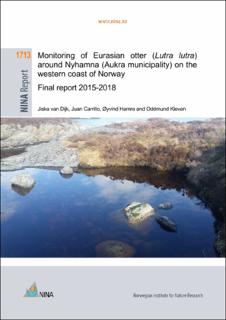Monitoring of Eurasian otter (Lutra lutra) around Nyhamna (Aukra municipality) on the western coast of Norway. Final report 2015-2018
Research report

Åpne
Permanent lenke
https://hdl.handle.net/11250/2654685Utgivelsesdato
2020Metadata
Vis full innførselSamlinger
- NINA Rapport/NINA Report [2341]
Sammendrag
Van Dijk, J., Carrillo, J., Hamre, Ø. og Kleven, O. 2020. Monitoring of Eurasian otter (Lutra lutra) around Nyhamna (Aukra municipality) on the western coast of Norway. Final report 2015-2018. NINA Report 1713. Norwegian Institute for Nature Research.
The main objectives of the long-term otter monitoring in and around Nyhamna is to gain knowledge on how industrial complexes such as Nyhamna affect the otter population in the surrounding area and to estimate otter density in the study area using DNA-analysis of non-invasively collected faecal samples. The monitoring project started in 2008 (Landa et al. 2009) and surveys were repeated in 2010, 2011 and 2012. The monitoring project continued in 2015 with finances for another four-year period which ended in 2018. To monitor the local otter population and obtain an estimate of the minimum number of animals living in the study area, we apply DNA-analysis of non-invasively collected faecal samples to identify individual otters. Taking the otter individuals that were found in different samples over the year and for which we can say that they are likely to be residential otters an estimation of the local otter density was calculated. DNA was extracted from 593 spraints and 268 of these samples resulted in a successful DNA-profile and a confirmed individual, which represents a success rate of ca. 45.2%. The 268 samples with confirmed individuals, were identified as being 20 females and 27 males. Females were often re-sampled (15 of the in total 20 females) and found in different samples in different years whereas males were less often re-sampled (nine of the in total 27 males), indicating that the female population is much more stable and resident than the more fluctuating and dispersed male population. The territories of males and females showed to partially overlap, similarly to other studies in Europe and we estimated the otter density on Aukra to be of 3.1 resident otters per 10 km of coastline when considering the otter individuals in 2018 that were also sampled in 2017. When looking at 2018 only, a total of 20 individuals were identified including both resident and non-resident otters resulting in an estimated population density of 4.4 individuals per 10 km of coastline. Unfortunately the samples collected on the industrial plant, inside the fence, were unsuccessful in DNA-profiling apart from one sample. It was remarkable that very few fresh spraints were found on the plant compared to the earlier study by Landa et al. (2008-2012). The intensive building activity during 2015 and early 2016 apparently resulted in less attractive otter habitat and otter activity on the plant. However as seen from the number of samples found and successfully DNA-profiled outside the fence of the industrial plant, together with our density estimation similar to the earlier study by Landa et al., the otter population may not have been affected by the constructions as such. Van Dijk, J., Carrillo, J., Hamre, Ø. og Kleven, O. 2020. Monitoring of Eurasian otter (Lutra lutra) around Nyhamna (Aukra municipality) on the western coast of Norway. Final report 2015-2018. NINA Report 1713. Norwegian Institute for Nature Research. Hovedmålene med den langsiktige oterovervåkningen i og rundt industrianlegget Nyhamna er å få kunnskap om hvordan industrikomplekser som Nyhamna påvirker lokale oterpopulasjoner og å estimere den lokale otertettheten ved hjelp av DNA-analyse av innsamlet ekskrementer. Overvåkningsprosjektet startet i 2008 (Landa et al. 2009) med gjentatte kartlegginger i 2010, 2011 og 2012. Prosjektet fortsatte i 2015 med finansiering for ytterligere fire år og ble avsluttet i 2018. For å overvåke den lokale oterpopulasjonen og få et estimat av minimum antall dyr som bor i studieområdet, brukte vi DNA-analyse av innsamlet avføring for å identifisere individuelle otere. Ved å bruke Oterindivider gjenfunnet i forskjellige prøver fra tidligere år, noe som tilsier at de sannsynligvis er etablert i områder, ble det beregnet et lokale otertetthet. DNA ble funnet i 593 prøver hvorav 268 av prøvene resulterte i en vellykket DNA-profil og et bekreftet oterindivid. Det representerer en suksessrate på ca. 45,2%. Av de 268 prøvene ble 20 hunn- og 27 hannotre identifisert. Hunnoterindivider ble ofte gjenfunnet på nytt fra forskjellige prøver forskjellige år (15 av 20 hunnotre), mens hannotere sjeldnere ble gjenfunnet (9 av 27 hannotre). Dette indikerer at hunnotre er mye mer stabile og etablerte i området enn hannotre. Territoriene til hanner og hunner viste seg delvis å overlappe. Dette er også vist i andre studier i Europa. Vi har estimert Aukras lokale otertetthet til 3,1 etablerte individer per 10 km kystlinje. I denne analysen inkluderte vi oterindividene som var registrert både i 2018 og 2017. Dersom man estimerer tetthet basert på alle de 20 individene som ble registrert i 2018 (både gjenfunnet og ikke gjenfunnet tidligere år), ble den estimerte lokale otertettheten 4,4 individer per 10 km kystlinje. Bortsett fra en vellykket prøve, lyktes det ikke med DNA-profilering på de øvrige prøvene som ble samlet inn innenfor gjerdet på Nyhamna industrianlegget. Det er bemerkelsesverdig at det ble funnet svært få ferske avføringsprøver på industrianlegget sammenlignet med den forrige studien av Landa et al. (2008-2012). De intensive bygningsaktivitetene i løpet av 2015 og 2016 resulterte i mindre attraktive leveområder og mindre aktivitet av oter innenfor gjerdet. Imidlertid, sett ut fra det store antallet avføringsprøver som ble funnet utenfor industrianlegget, og vår lokal tetthetsberegning av oter som viser sammenlignbare tettheter med den forrige studien av Landa et al. fra 2012, ser det ut til at oterbestanden på Aukra sannsynligvis ikke har blitt påvirket av de intensive bygningsaktivitetene på anlegget.